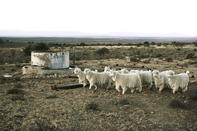
Marketing of Mohair
Small-scale Angora goat farmers can make use of communal shearing points but commercial farmers arrange with a shearing team to visit their farms during shearing time. After shearing, mohair is classed according to length, strength and texture, packed in bales and marked with a producer number and the quality class. Each registered South African mohair producer has a producer number. Individual bales can weigh up to 150 kg.
Small-scale farmers should keep records of their individual contribution to a bale to get paid for that. Bales are transported to the broker, who will market the mohair and sell it on auctions, held about 14 times per year at the Wool and Mohair Exchange in Port Elizabeth. Bales will be separated into lots and samples of each lot will be presented to buyers.
A buyer will buy a ‘lot' of the raw fibre (also called ‘greasy’) and will then process it further. Processing of mohair includes sorting, scouring (Washing), carding, combing, spinning, dyeing, weaving or knitting and finally, finishing.
Buyers for South African production make up about 5% while 95% of mohair is sold for export. South Africa's three largest export countries are China, Italy and Taiwan. Currently (2018) there are five main buyers, three brokers and approximately 30 manufacturers.
A wide variety of mohair products are produced in South Africa including socks, blankets, duvets, scarves, as well as a range of other clothing and décor items. Abroad, mohair is used by high-end fashion labels to manufacture luxury suits and other fashion items. Mohair South Africa supplies market information to Angora goat farmers and the industry.
Mohair Statistics in South Africa
Mohair is produced in dry areas of the USA and Australia as well as in Lesotho, but South Africa produces about 53% of the world's mohair production. The gross value of mohair production was about R529 million in 2015.
Production for 2015 (2 500 tons) was a substantial decline compared to 2006 production figures of about 3 700 tons. A big contributor to this decline was the severe drought experienced in a large part of the production areas of the Eastern Cape Province. In 2006 the price of mohair was R78/kg compared to 2018 when the price reached R250/kg.
Problems with Mohair Production
South Africa is still (2018) under major pressure from the persisting drought across large parts of the mohair producing regions. Some areas have received some much-needed rain, but a number of producers are still spending massive amounts of money on supplementary feed (and transporting it) to sustain their animals. However, there is still good demand for mohair and the markets have been stable over the last few auctions.
Some other challenges in the South African mohair industry include insufficient quantities of raw material to arrive on the right time, high replacement costs of processing machinery, limited textile knowledge and skills as well as inflexible labour legislation to accommodate seasonality of production.
By Marinda Louw